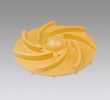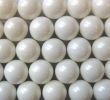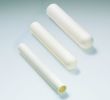Zirconia or zirconium oxide
Zirconia or zirconium oxide is a polycrystalline ceramic, which means that it does not contain a glassy phase. It has many mechanical and thermal properties such as excellent resistance to high temperatures, very good chemical inertia and high dimensional stability. These characteristics make zirconia ceramic a material of choice for refractory applications, as well as for high-performance applications in the medical field. It can be found naturally in certain minerals or obtained by chemical derivation from zircon.
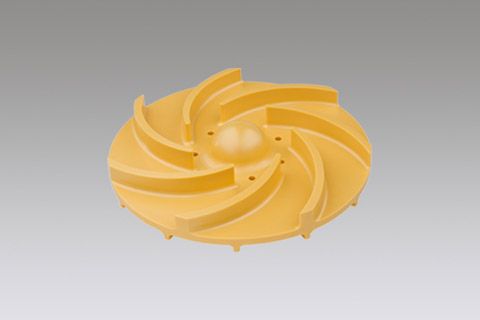
What are the properties of zirconia ceramic?
Zirconia is a technical ceramic known for its resistance to high temperatures and thermal shocks. It also has a fairly high density for a ceramic material (5.8 g/cm3 density) and a remarkable hardness. It is also a good thermal insulator, becoming electrically conductive at high temperatures around 800 °C.
Its excellent dimensional stability, even at very high temperatures, and its mechanical strength (resistant to wear, corrosion and mechanical abrasion) allow it to offer a long operational life, particularly in the chemical industry, for example as a pump component.
Finally, what differentiates zirconium oxide from other ceramic materials such as alumina are its excellent chemical inertness and its biocompatibility with the human body. These two properties make it the ideal material for medical applications.
| Material | FZM (Mg-PSZ) | DEGUSSIT FZY | 3Y-TZP | 8Y-FSZ | DEGUSSIT ZR25 | FZM+ |
| Microstructure | ||||||
| Composition (by weight) | ZrO2 + 3,2 % MgO | ZrO2 + 8,2 %Y2O3 | ZrO2 + 5,2 %Y2O3 | ZrO2 + 13 %Y2O3 | ZrO2 + MgO | ZrO2 + MgO |
| Density | >5,70 | >5,50 | 6,05 | 5,7 | >4,3 | >5,75 |
| Open porosity (%) | 0 | 0 | 0 | 0 | 24 | 0 |
| Grain size (µm) | 50 | 30 | <0,5 | 25 | ||
| Mechanical properties | ||||||
| Compressive strength (MPa) | 2000 | 2000 | 1500 | 2000 | ||
| Flexural strength (MPa) | 500 | 400 | 1150 | 180 | 40 | 900 |
| Modulus of elasticity (GPa) | 185 | 200 | 200-250 | 160 | 215 | |
| Thermal properties | ||||||
| Maximum operating temperature (°C) | 900 | 1700 | 1200 | 2000 | 2200 | 500 |
| Specific heat (J/Kg.K) | 400 | 400 | 490 | |||
| Thermal conductivity at 100 °C (W/m.K) | 3 | 2,5 | 2,5 - 3 | 2,5 | 3,75 | |
| Thermal conductivity at 1000 °C (W/m.K) | 2 | |||||
| Coefficient of expansion (10-6/K) | 10,6 | 10,9 | 9,6 | 11 | 6 - 7 | 10,3 |
| Electrical properties | ||||||
| Resistance at 20 °C (ohm.cm) | 1010 | 1010 | ||||
| Resistance at 1000 °C (ohm.cm) | 84 | 15 | ||||
What are the different types of zirconia?
We offer products in different types of Kyocera zirconia. Partially magnesium oxide stabilised zirconia (FZM (Mg-PSZ)) is particularly hard, dense and wear resistant, making it a very good choice for the manufacture of components that are subject to friction, such as pump parts. FZM+ zirconia is an "improved" version of magnesia-stabilised zirconium oxide: it has a much higher bending strength (900 MPa compared to 500 MPa for conventional FZM).
We also offer 3 types of yttria-stabilised zirconia. Kyocera DEGUSSIT FZY zirconia is partially stabilised with 5 mol% yttrium oxide. Zirconia 3Y-TZP is partially stabilised with 3 mol% yttrium oxide. Finally, 8Y-FSZ zirconia is fully stabilised with 8 mole % yttrium oxide, in a cubic form that can withstand temperatures of up to 2000 °C.
Finally, our products can also be obtained in DEGUSSIT ZR25 zirconia, partially stabilised with magnesium oxide. This is a porous zirconia, which is most resistant to high temperatures (up to 2200 °C) and thermal shocks.
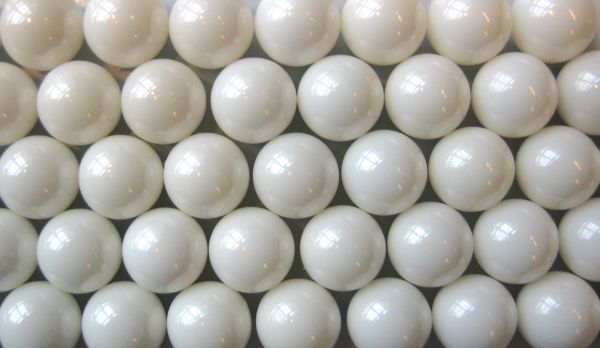
Our standard products in zirconium oxide
Our standard products include ranges of precision balls in 3Y-TZP zirconia, as well as tubes and sheaths designed specifically for oxygen probes in DEGUSSIT FZY. We also sell flat-bottomed cylindrical crucibles in zirconia ceramic, high form conical crucibles, and combustion boxes, which are ideal products for high temperature applications.
We also offer semi-finished products in zirconium oxide: round and rectangular plates, rods, rods and rods. Finally, we can machine parts to drawings on request when our customers have special requirements for precision parts.
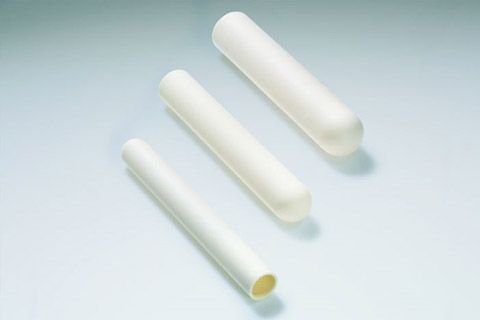
Areas of use of zirconia
Zirconia is a material that is often used for its properties such as resistance to wear, thermal shock and high temperatures in application sectors requiring the use of refractory materials such as pistons for high pressure pumps, wear parts in industry, cutting blades, casting of precious metals or sliding floors.
Zirconia is also used in electronics and, above all, in medical applications. Its very good properties, such as its excellent wear resistance, make it possible to manufacture durable components. In addition, the chemical inertness of zirconium oxide and its biocompatibility with the human body make it ideal for medical applications such as the manufacture of hip prostheses to replace metal prostheses or even more often for the manufacture of dental implants or crowns with a natural appearance.





